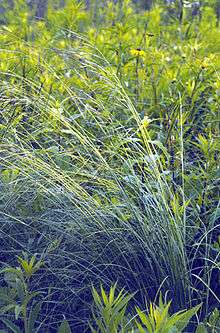Stipa spartea
| Stipa spartea | |
|---|---|
 | |
| Scientific classification | |
| Kingdom: | Plantae |
| (unranked): | Angiosperms |
| (unranked): | Monocots |
| (unranked): | Commelinids |
| Order: | Poales |
| Family: | Poaceae |
| Genus: | Stipa |
| Species: | S. spartea |
| Binomial name | |
| Stipa spartea Trin. | |
| Synonyms | |
|
Hesperostipa spartea - (Trin.) Barkworth | |
Stipa spartea - renamed Hesperostipa spartea, and commonly called Porcupine grass, is a bunchgrass species in the genus Stipa.[1]
Stipa spartea or Hesperostipa spartea is native to the Great Plains and Canadian Prairies of North America.[1] It is also found in grasslands of the Rocky Mountains in Western Canada and the Western United States.[1]
Description
Hesperostipa spartea has a bunchgrass foliage mass of 3–6 feet (0.91–1.83 m) in diameter [2] The flower stalks are upright and arching, yellow, in late Spring.[2]
The seeds are needle-like with sharp tips and long tails.[2] The tails are composed of two different strands that dry at different rates and twist around each other, causing the sharp head of the seed to be driven into the soil. Just behind the sharp, needle-like tip, is a collar of long thick hairs that face backward, preventing the seeds from working their way back out of the soil.
This species of grass can have its seeds entangled in sheep's hair while they are feeding, and once entangled it often works its way into the animal's skin.

Cultivation
Hesperostipa spartea is cultivated as an ornamental grass for native plant gardens and natural landscaping, and as a plant for Great Plains—Prairie habitat restoration.[2]
References
- 1 2 3 USDA - Hesperostipa spartea . accessed 6.26.2012
- 1 2 3 4 NPIN: Hesperostipa spartea . accessed 6.26.2012.
External links
![]() Media related to Hesperostipa spartea at Wikimedia Commons
Media related to Hesperostipa spartea at Wikimedia Commons
- USDA Plants Profile for Hesperostipa spartea (Porcupinegrass)
- Lady Bird Johnson Wildflower Center Native Plant Information Network (NPIN) — Hesperostipa spartea (Porcupine grass)